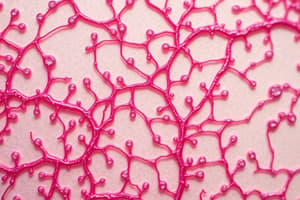Podcast
Questions and Answers
What is the main function of plasma cells?
What is the main function of plasma cells?
- To produce heparin
- To produce antibodies (correct)
- To secrete histamine
- To engulf melanin pigment
What is the characteristic feature of the cytoplasm of mast cells?
What is the characteristic feature of the cytoplasm of mast cells?
- Basophilic granular (correct)
- Rich in lysosomes
- Deeply basophilic
- Rich in melanin granules
What is the function of melanophores?
What is the function of melanophores?
- To produce antibodies
- To phagocytose microorganisms
- To carry melanin pigment (correct)
- To secrete heparin
What type of connective tissue is characterized by very fine collagen fibers and mucoid matrix?
What type of connective tissue is characterized by very fine collagen fibers and mucoid matrix?
What is the origin of free macrophages?
What is the origin of free macrophages?
What is the function of leucocytes in connective tissue?
What is the function of leucocytes in connective tissue?
What type of connective tissue is characterized by a soft, jelly-like substance rich in mucin?
What type of connective tissue is characterized by a soft, jelly-like substance rich in mucin?
What is the shape of the nucleus of plasma cells?
What is the shape of the nucleus of plasma cells?
What is the main function of loose areolar connective tissue?
What is the main function of loose areolar connective tissue?
Which type of adipose connective tissue is rich in blood capillaries and pigments?
Which type of adipose connective tissue is rich in blood capillaries and pigments?
What is the main difference between unilocular and multilocular adipose connective tissue?
What is the main difference between unilocular and multilocular adipose connective tissue?
Where is white collagenous connective tissue mainly found?
Where is white collagenous connective tissue mainly found?
What is the main characteristic of yellow elastic connective tissue?
What is the main characteristic of yellow elastic connective tissue?
What is the function of unilocular adipose connective tissue?
What is the function of unilocular adipose connective tissue?
Where is loose areolar connective tissue mainly found?
Where is loose areolar connective tissue mainly found?
What is the main difference between regular and irregular white collagenous connective tissue?
What is the main difference between regular and irregular white collagenous connective tissue?
Flashcards are hidden until you start studying
Study Notes
Connective Tissue Cells
- Plasma cells: originate from B-lymphocytes, produce antibodies, and defend the body against infection
- Mast cells: oval shape, basophilic granular cytoplasm, central rounded nucleus, secrete heparin (anticoagulant) and histamine (allergic)
- Pigment cells (melanophores): connective tissue macrophages, carry melanin pigment
- Leucocytes: blood leucocytes that migrate to connective tissue, increase in cases of infection to phagocytose microorganisms
- Free macrophages: arise from blood monocytes, irregular surface, phagocytic cells, share in immune defense of the body
Connective Tissue Types
-
Embryonic connective tissue:
- Mucous connective tissue
- Mesenchymal connective tissue
-
Connective tissue proper:
- Loose areolar connective tissue
- Adipose connective tissue
- White collagenous connective tissue
- Yellow elastic connective tissue
- Reticular connective tissue
Mucous Connective Tissue
- Formed of CT cells, mesenchymal cells, fine collagen fibers, and mucoid matrix
- Sites: umbilical cord, vitreous humor of the eyeball, pulp of growing teeth
- Function: support the organs
Loose Areolar Connective Tissue
- Formed of all types of CT fibers, cells, and loose matrix
- Sites: around organs and blood vessels, subcutaneous connective tissue, submucosa and serous membranes
- Function: binds tissues together, surrounds organs
Adipose Connective Tissue
- Similar to loose areolar CT, but rich in fat cells
- Types:
- Unilocular adipose CT (White fat): fat cells with one large globule of fat, signet ring appearance
- Multilocular adipose CT (Brown fat): fat cells with multiple small globules of fat, provides heat for newborn babies
White Collagenous Connective Tissue
- Formed mainly of white collagen fibers and fibroblast cells
- Types:
- Regular type: regularly arranged collagen fibers, sites: tendon of muscles, ligaments, cornea of the eye
- Irregular type: irregularly arranged collagen bundles, sites: deep fascia, dermis of the skin, perichondrium of cartilage
Yellow Elastic Connective Tissue
- Elastic and stretchable, yellow in fresh state, stained with orcein stain
- Formed of yellow elastic fibers, fibroblast cells, and little matrix
- Sites: ligamenta flava, true vocal cord, wall of blood vessels
Studying That Suits You
Use AI to generate personalized quizzes and flashcards to suit your learning preferences.



